Religion and Politics in India
Introduction, religion and politics in india before independence, relationship between religious and political beliefs, relationship between religion and groups/institutions, works cited.
Globally, religion has always played an integral part in influencing political culture of nations. For many decades, not only has religion influenced social living through its doctrine teachings, but also has been continuously powerful in propelling political ideologies in many nations. Coupled with its linguistic federalism, ethnic problems, and religious discrimination issues, religions have historically spurred political mobilization.
Several Asian studies have constantly indicated a great connection among religions and political development and reforms of the Asian continent, before and after their independence. Two main historical religions of India, the Hinduism, and the Muslim have greatly contributed to fragmented Indian nationalism, with this nation experiencing a mixture of peace and hostility resulting from religious politics. Religious attrition and differences in India before and after its independence may have been significant to the India’s politics. Central to examining democracy development in India, the essay explores the association religion and politics in India before and after independence.
Major political transformations in India greatly associates with the involvement of religious political movements, which since history initiated communal participation in development of nationalism of India (Moore 316). Before independence, political pressure was eminent in India and characterised by political differences between non-Hindu and ethnic minority. Indian State was initially a nation that served in the ideology of secular nationalism under the reign of secular Congress Party that dominated Indian politics (Sahu 243). However, Hinduism was politically influential but their Muslim counterparts remaining sceptical about Hindus religious politics.
Before independence, the caste notion in Hindu society was most influential in social and political organisation. Moore (317) describes “caste system as the organisation of the population into hereditary and endogamous groups” where males engaged in social and political functions. There were four castes in hierarchical order and associated with spiritual, social and political progression in India. Sahu (246) identifies the castes as “Brahmanas (priests and scholars), Kshatriyas (political rulers and soldiers), Vaishyas (merchants and cultivators), and Sudras (artisans and labourers)”
The caste system significantly contributed to political systems in India during the Mogul era from sixteenth century throughout to eighteenth century. The caste system strongly engaged in political reforms and improved the lives of Hindus, though with limited operations following incessant confrontations with the Muslims. As stated by Moore (317), “caste served, and still serves, to organise the life of village community, the basic cell of the Indian society and the fundamental unit that determined strong leadership.” The caste system having a great affiliation with the Hindu religion had significant obstruction to Indian democracy as history identifies this socio-political system as an era of agrarian bureaucracy.
Caste system symbolized the Indian polity and imposed political governance based on military rule that supported taxation and leadership under the chieftains. This means that politicians of Mogul era used the caste reservations to acquire unfair wealth.
The differences towards nationalism before independence of Hindu and formation of the Muslim-dominate Pakistan may be the potential backdrop to fragmented political beliefs and stands in India (Moore 371). Subsequent to Indian partition, disparity commenced intensely on political ideologies as Muslims had most majority of its potential leaders to the Muslim-dominate Pakistan. Following such issues “Indian Muslims supported and voted for the secular Congress party on the understanding that the Congress government would maintain Muslim Personal Law and other aspects of the Muslim culture” (Sahu 245).
The confrontation between the Muslim and the Hindus continued when the Hindu nationalist parties including Bharatiya Janata Party (BJP), Rastriya Swayamsevak Sangh (RSS) pressured the secularist Congress Party that began losing its political authority after the split. Along religious differences, proponents of secularism and Hinduism have always differed in political beliefs regarding to nationalism and doctrine that should dominate national leadership. Despite having greater political influence, Hinduism has failed to consolidate its religious authority in India.
Hinduism is the most complicated religion as each cultural linguistic zone contains its own worshiping culture and doctrine. As noted by Sahu (245), “Hindus worship different gods and goddesses, which are limited portrayals of the unlimited – ultimate reality that is formless, nameless and without personality.” Coupled with the fact that the BJP possesses leaders from Hindus, but with different religious ideologies following their broad cultural homogeneity, there exists no state religion with dominant principles in national governance. Each of the political parties contains a mixture of religious cultures practiced concomitantly, with each of the two religions influencing each other ideologically (Moore 368).
Contesting to the power of nationalism, none of the religions has managed to conquer national governance. Being proponents of secularism, Muslim differ distinctively in religious ideologies; other minor religions differ with Hinduism, and Hindus themselves have differing doctrine principles. Having shared religious power in national governance where both Muslim and Hindu religious practices apply, there is no State religion.
The India’s partition of 1947 was arguably the backdrop to formation of political groups and institutions that emerged on religious divide. Thought to be the solution towards political differences between the Hindus and the Muslim, the 1947 partition itself was the course of major political pressures in India (Moore 371). Majority Hindus differ between themselves, Muslims have different religious ideologies and Christians, and other minority groups differ as well. BJP, Ram Rajya Parishad, and RSS who were the most anti-congress parties continually existed on the foundations of Hinduism or Hindu nationalism.
Contrary to its opponents, majority of Muslims commenced with their support over Congress secularist party. Following incessant religious attritions on which religion should become a state religion, politics of India divided along linguistic lines. According to Sahu, “religious politics divided as follows: “Indian Muslims developed their own form of occupation-based caste distinction (247); Sikhs demanded a creation of a Punjabi-speaking province” (248) and Hindus remained devoted to their motive of making India a Hinduism state.
The history associated with India’s political transformations on religious grounds is considerably diverse and complicated. Religious contribution to Indian nationalism has remained a convoluted issue, with all religions existing in India having different ideologies towards state nationalism. The Indian Muslims who remained in India after the 1947 partitioning strongly opposes the efforts of Hindus in developing of Hindu nationalism, Christians and other minority religions have had a notion of discrimination.
In addition, Hindu themselves posses different religious ideologies, with some worshiping single god, others worshiping several gods, with all having different worshiping centres. India is still a nation of many religions with shared political influence and none of the religions has dominance in the national governance. This means that efforts of partitioning India into India and Muslim-dominated Pakistan was not a solution towards religious differences as the remaining Indian Muslims have also had significant political consequences in the India’s political stand.
Moore, Barrington. Social origins of dictatorship and democracy: Lord and peasant in the making of the modern world, Boston, Massachusetts: Beacon Press, 1967. Print.
Sahu, Sunil. Religion and politics in India: The emergence of Hindu Nationalism and the Bharatiya Janata Party (BJP) Cambridge: Cambridge University Press, 2002. Print.


Essay on Religion and Politics in India
Students are often asked to write an essay on Religion and Politics in India in their schools and colleges. And if you’re also looking for the same, we have created 100-word, 250-word, and 500-word essays on the topic.
Let’s take a look…
100 Words Essay on Religion and Politics in India
Introduction.
Religion and politics in India are deeply intertwined. India is a land of diverse religions, and this diversity influences its political landscape.
Religious Influence
Religion plays a significant role in Indian politics. Many political parties are based on religious identities, leading to a blend of religion and politics.
Secularism in Politics
Despite the religious influence, India is a secular country. The government is committed to treating all religions equally, ensuring no discrimination.
Challenges and Conclusion
While the blend of religion and politics can create unity, it can also lead to conflicts. It’s crucial for India to maintain its secular nature while respecting religious diversity.
250 Words Essay on Religion and Politics in India
India, a country of diverse cultures and religions, has always found its politics deeply intertwined with religion. This amalgamation has significantly influenced the socio-political landscape of the nation, shaping its democratic ethos and electoral politics.
Historical Perspective
The birth of India as an independent nation was marked by a partition along religious lines, setting a precedent for the interplay between religion and politics. The political discourse in India has been marked by religious identity, with parties often using religion as a tool to mobilize voters.
Religion as a Political Tool
Religion in India is not just a spiritual matter; it’s a socio-political entity. Political parties capitalize on religious sentiments to foster a sense of identity and unity among their supporters. This strategy often leads to the polarization of society along religious lines, creating a breeding ground for communal tensions.
Secularism and Politics
The Indian constitution advocates for secularism, ensuring equal rights and freedom for all religions. However, the practical implementation often gets blurred with political interests. The selective use of secularism by political parties to appease certain religious groups has raised questions about the true essence of Indian secularism.
The intersection of religion and politics in India is a complex phenomenon. While religion plays a significant role in shaping political ideology and voter behavior, it also poses challenges to India’s secular fabric. Striking a balance between religious freedom and political integrity is crucial for the sustenance of India’s pluralistic democracy.
500 Words Essay on Religion and Politics in India
The interplay of religion and politics in india.
India is a country characterized by a rich cultural, religious, and political tapestry. The interplay of religion and politics in India is a complex and profoundly influential dynamic that shapes the nation’s social and political landscapes.
The Historical Context
The intertwining of religion and politics in India is deeply rooted in its historical context. The nation’s partition in 1947, based on religious lines, set the stage for religion to become a central player in political discourse. The political ideologies that emerged, such as secularism and communalism, were deeply influenced by religious considerations.
Religion in Political Discourse
Religion plays a significant role in the political discourse in India. Political parties often employ religious symbolism and rhetoric to mobilize support. This can be seen in the way political campaigns are often crafted around religious identities, with promises made to protect the interests of specific religious communities. This has led to a form of identity politics where religious affiliations often dictate political alignments.
Religious Mobilization and Vote Bank Politics
The concept of ‘vote bank’ politics has further entrenched the role of religion in Indian politics. Political parties often target specific religious communities, promising to protect their interests in return for their votes. This has created a situation where religion is used as a tool to garner political support, often leading to divisive politics and communal tensions.
The Challenges and Implications
While religion can provide a sense of identity and community, its intertwining with politics has led to a number of challenges. It has often resulted in divisive politics, fostering communal tensions and sometimes even leading to violence. The politicization of religion also undermines the secular ideals enshrined in the Indian constitution, which envisages India as a secular state where all religions are treated equally.

The Way Forward
The way forward lies in strengthening the secular fabric of the nation. This requires promoting a political culture where religion is not used as a tool for political gains. It involves fostering a sense of inclusive nationalism that transcends religious identities. Education and awareness can play a crucial role in this, helping to promote a culture of tolerance and mutual respect.
In conclusion, religion and politics in India are deeply intertwined, shaping the nation’s social and political landscapes. While this dynamic has led to challenges, it also presents opportunities for fostering a more inclusive and tolerant society. By promoting a culture of secularism and mutual respect, India can ensure that religion serves as a force for unity rather than division.
That’s it! I hope the essay helped you.
If you’re looking for more, here are essays on other interesting topics:
- Essay on Regionalism in India
- Essay on Quit India Movement
- Essay on Proud to Be an Indian
Apart from these, you can look at all the essays by clicking here .
Happy studying!
Leave a Reply Cancel reply
Your email address will not be published. Required fields are marked *
Save my name, email, and website in this browser for the next time I comment.
Read our research on: Abortion | International Conflict | Election 2024
Regions & Countries
1. religious freedom, discrimination and communal relations.
Indians generally see high levels of religious freedom in their country. Overwhelming majorities of people in each major religious group, as well as in the overall public, say they are “very free” to practice their religion. Smaller shares, though still majorities within each religious community, say people of other religions also are very free to practice their religion. Relatively few Indians – including members of religious minority communities – perceive religious discrimination as widespread.
At the same time, perceptions of discrimination vary a great deal by region. For example, Muslims in the Central region of the country are generally less likely than Muslims elsewhere to say there is a lot of religious discrimination in India. And Muslims in the North and Northeast are much more likely than Muslims in other regions to report that they, personally, have experienced recent discrimination.
Indians also widely consider communal violence to be an issue of national concern (along with other problems, such as unemployment and corruption). Most people across different religious backgrounds, education levels and age groups say communal violence is a very big problem in India.
The partition of the Indian subcontinent in 1947 remains a subject of disagreement. Overall, the survey finds mixed views on whether the establishment of Hindu-majority India and Muslim-majority Pakistan alleviated communal tensions or stoked them. On balance, Muslims tend to see Partition as a “bad thing” for Hindu-Muslim relations, while Hindus lean slightly toward viewing it as a “good thing.”
Most Indians say they and others are very free to practice their religion
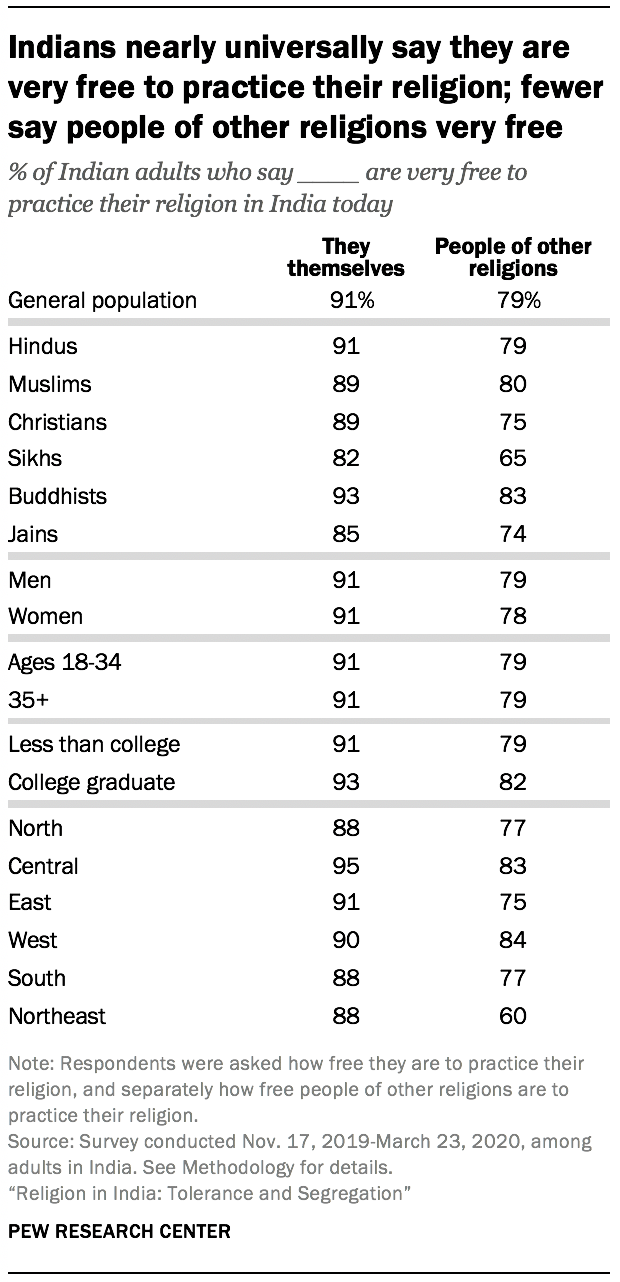
Broadly speaking, Indians are more likely to view themselves as having a high degree of religious freedom than to say that people of other religions are very free to practice their faiths. Still, 79% of the overall public – and about two-thirds or more of the members of each of the country’s major religious communities – say that people belonging to other religions are very free to practice their faiths in India today.
Generally, these attitudes do not vary substantially among Indians of different ages, educational backgrounds or geographic regions. Indians in the Northeast are somewhat less likely than those elsewhere to see widespread religious freedom for people of other faiths – yet even in the Northeast, a solid majority (60%) say there is a high level of religious freedom for other religious communities in India.
Most people do not see evidence of widespread religious discrimination in India
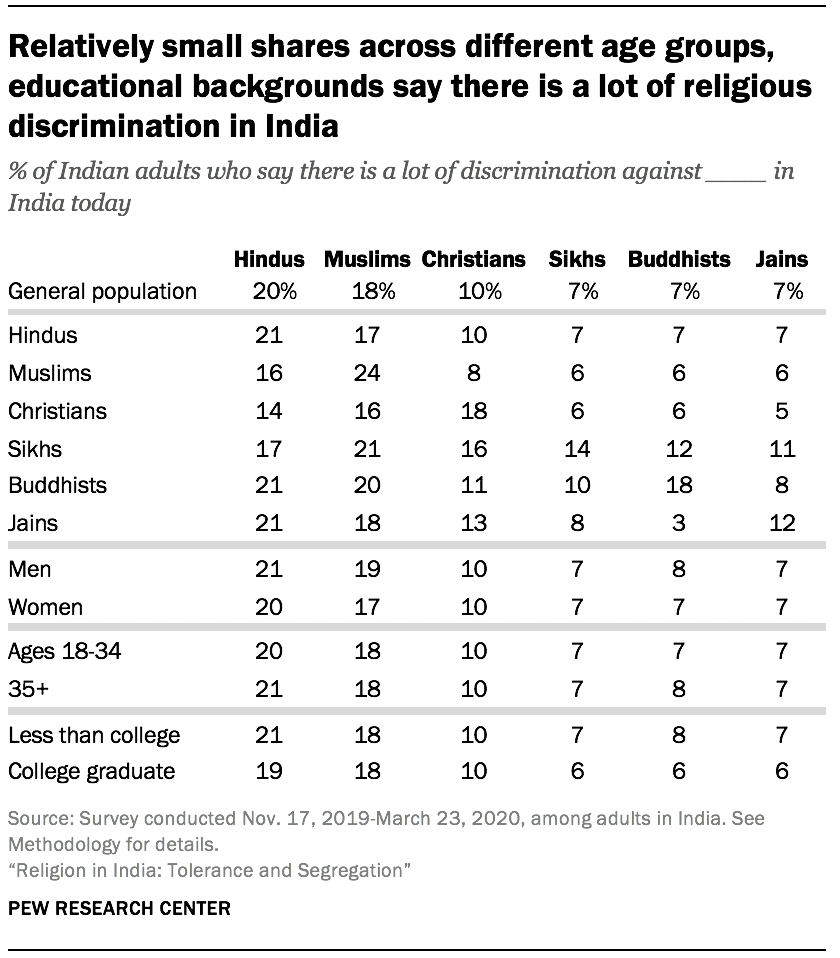
Generally, Indians’ opinions about religious discrimination do not vary substantially by gender, age or educational background. For example, among college graduates, 19% say there is a lot of discrimination against Hindus, compared with 21% among adults with less education.
Within religious groups as well, people of different ages, as well as both men and women, tend to have similar opinions on religious discrimination.
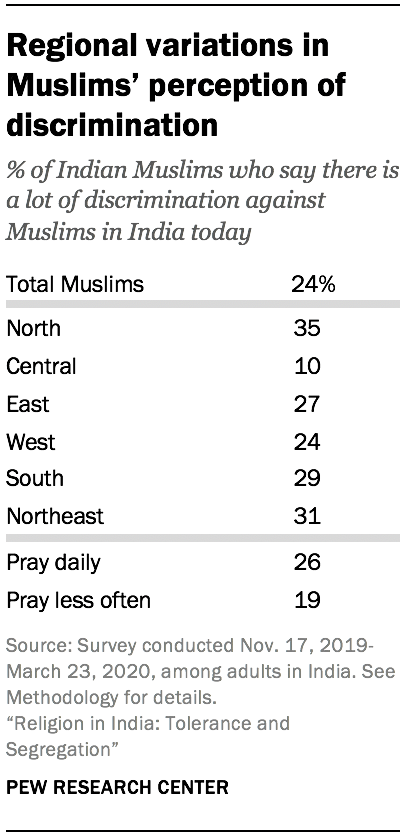
Among Muslims, perceptions of discrimination against their community can vary somewhat based on their level of religious observance. For instance, about a quarter of Muslims across the country who pray daily say there is a lot of discrimination against Muslims (26%), compared with 19% of Muslims nationwide who pray less often. This difference by observance is pronounced in the North, where 39% of Muslims who pray every day say there is a lot of discrimination against Muslims in India, roughly twice the share among those in the same region who pray less often (20%).
Most Indians report no recent discrimination based on their religion

Nationally, men and women and people belonging to different age groups do not differ significantly from each other in their experiences with religious discrimination. People who have a college degree, however, are somewhat less likely than those with less formal schooling to say they have experienced religious discrimination in the past year.
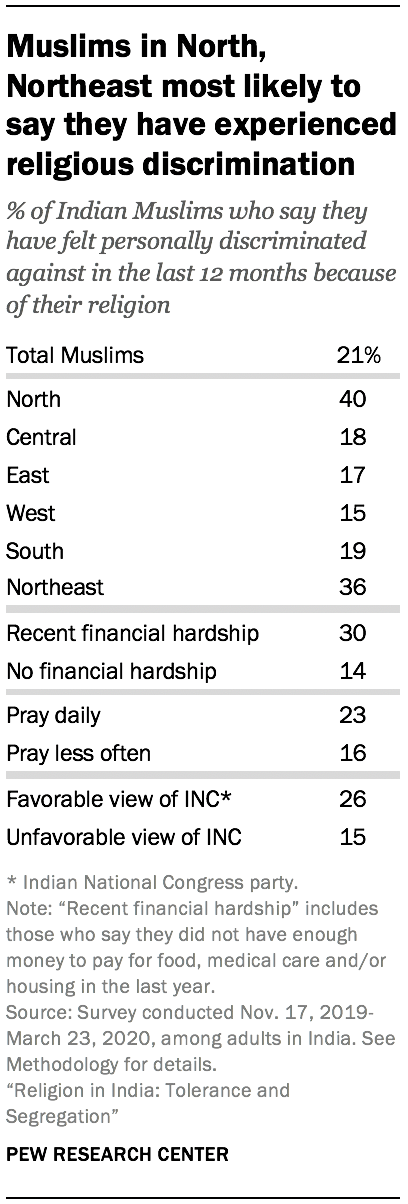
Experiences with religious discrimination also are more common among Muslims who are more religious and those who report recent financial hardship (that is, they have not been able to afford food, housing or medical care for themselves or their families in the last year).
Muslims who have a favorable view of the Indian National Congress party (INC) are more likely than Muslims with an unfavorable view of the party to say they have experienced religious discrimination (26% vs. 15%). Among Northern Muslims, those who have a favorable view of the INC are much more likely than those who don’t approve of the INC to say they have experienced discrimination (45% vs. 23%). (Muslims in the country, and especially Muslims in the North, tend to say they voted for the Congress party in the 2019 election. See Chapter 6 .)
Hindus with less education and those who have recently experienced poverty also are more likely to say they have experienced religious discrimination.
In Northeast India, people perceive more religious discrimination
Less than 5% of India’s population lives in the eight isolated states of the country’s Northeastern region. This region broadly lags behind the country in economic development indicators. And this small segment of the population has a linguistic and religious makeup that differs drastically from the rest of the country.
According to the 2011 census of India, Hindus are still the majority religious group (58%), but they are less prevalent in the Northeast than elsewhere (81% nationally). The smaller proportion of Hindus there is offset by the highest shares of Christians (16% vs. 2% nationally) and Muslims (22% vs. 13% nationally) in any region. And based on the survey, the region also has a higher share of Scheduled Tribes than any other region in the country (25% vs. 9% nationally), and half of Scheduled Tribe members in the Northeast are Christians.
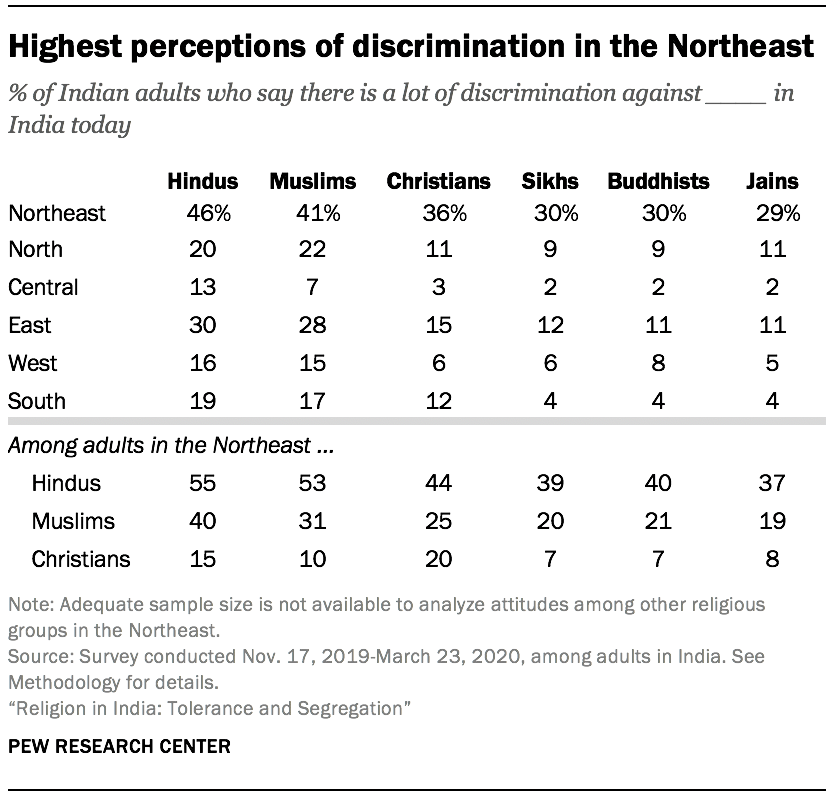
Much of the Northeast’s perception of high religious discrimination is driven by Hindus in the region. A slim majority of Northeastern Hindus (55%) say there is widespread discrimination against Hindus in India, while almost as many (53%) say Muslims face a lot of discrimination. Substantial shares of Hindus in the Northeast say other religious communities also face such mistreatment.
The region’s other religious communities are less likely to say there is religious discrimination in India. For example, while 44% of Northeastern Hindus say Christians face a lot of discrimination, only one-in-five Christians in the Northeast perceive this level of discrimination against their own group. By contrast, at the national level, Christians are more likely than Hindus to see a lot of discrimination against Christians (18% vs. 10%).
People in the Northeast also are more likely to report experiencing religious discrimination. While 17% of individuals nationally say they personally have felt religious discrimination in the last 12 months, one-third of those surveyed in the Northeast say they have had such an experience. Northeastern Hindus, in particular, are much more likely than Hindus elsewhere to report recent religious discrimination (37% vs. 17% nationally).
Most Indians see communal violence as a very big problem in the country
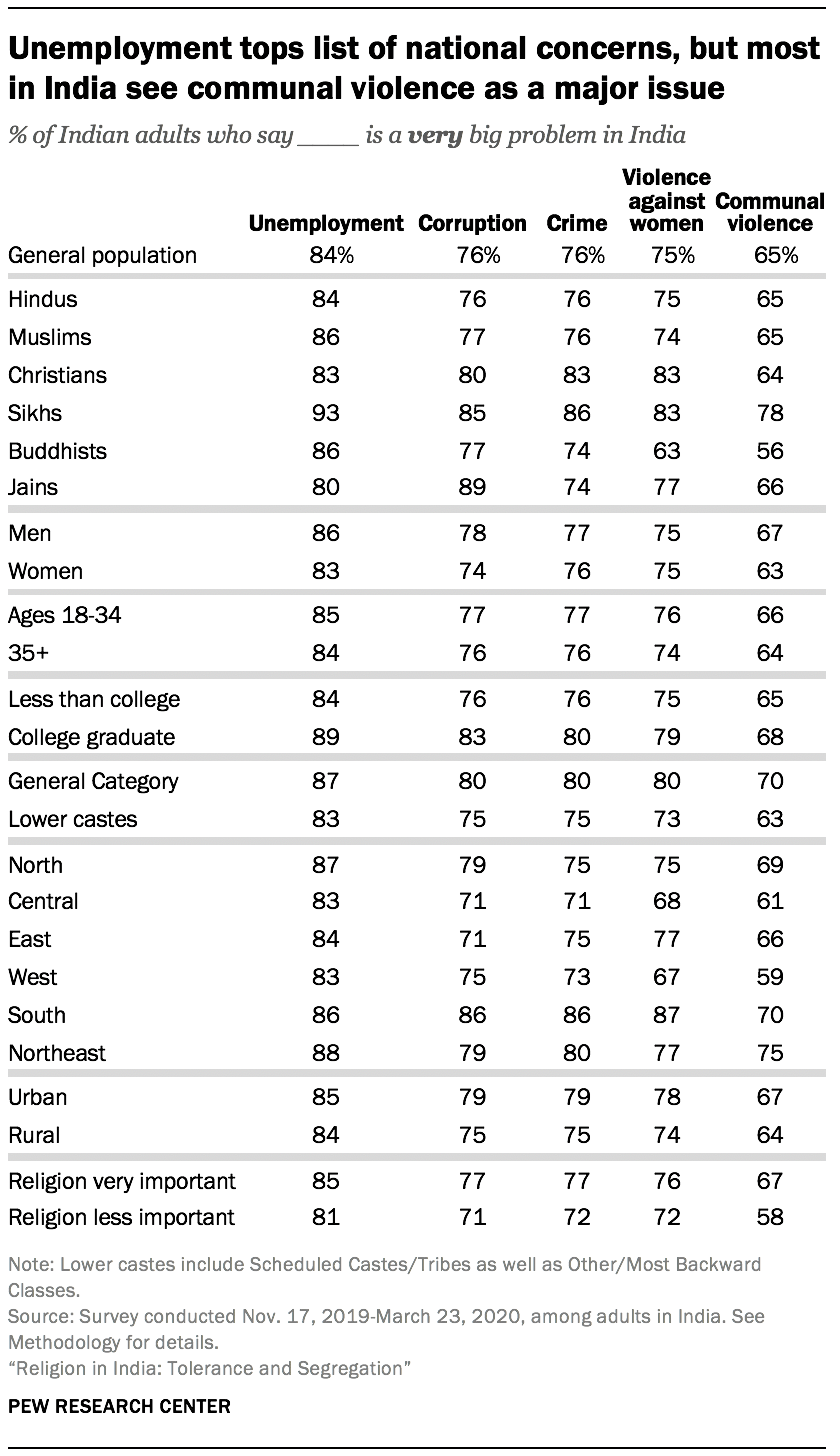
But even larger majorities identify several other national problems. Unemployment tops the list of national concerns, with 84% of Indians saying this is a very big problem. And roughly three-quarters of Indian adults see corruption (76%), crime (76%) and violence against women (75%) as very big national issues. (The survey was designed and mostly conducted before the World Health Organization declared the COVID-19 outbreak a pandemic.)
Indians across nearly every religious group, caste category and region consistently rank unemployment as the top national concern. Buddhists, who overwhelmingly belong to disadvantaged castes, widely rank unemployment as a major concern (86%), while just a slim majority see communal violence as a very big problem (56%).
Sikhs are more likely than other major religious groups in India to say communal violence is a major issue (78%). This concern is especially pronounced among college-educated Sikhs (87%).
Among Hindus, those who are more religious are more likely to see communal violence as a major issue: Fully 67% of Hindus who say religion is very important in their lives consider communal violence a major issue, compared with 58% among those who say religion is less important to them.
Indians in different regions of the country also differ in their concern about communal violence: Three-quarters of Indians in the Northeast say communal violence is a very big problem, compared with 59% in the West. Concerns about communal violence are widespread in the national capital of Delhi, where 78% of people say this is a major issue. During fieldwork for this study, major protests broke out in New Delhi (and elsewhere) following the BJP-led government’s passing of a new bill, which creates an expedited path to citizenship for immigrants from some neighboring countries – but not Muslims.
Indians divided on the legacy of Partition for Hindu-Muslim relations
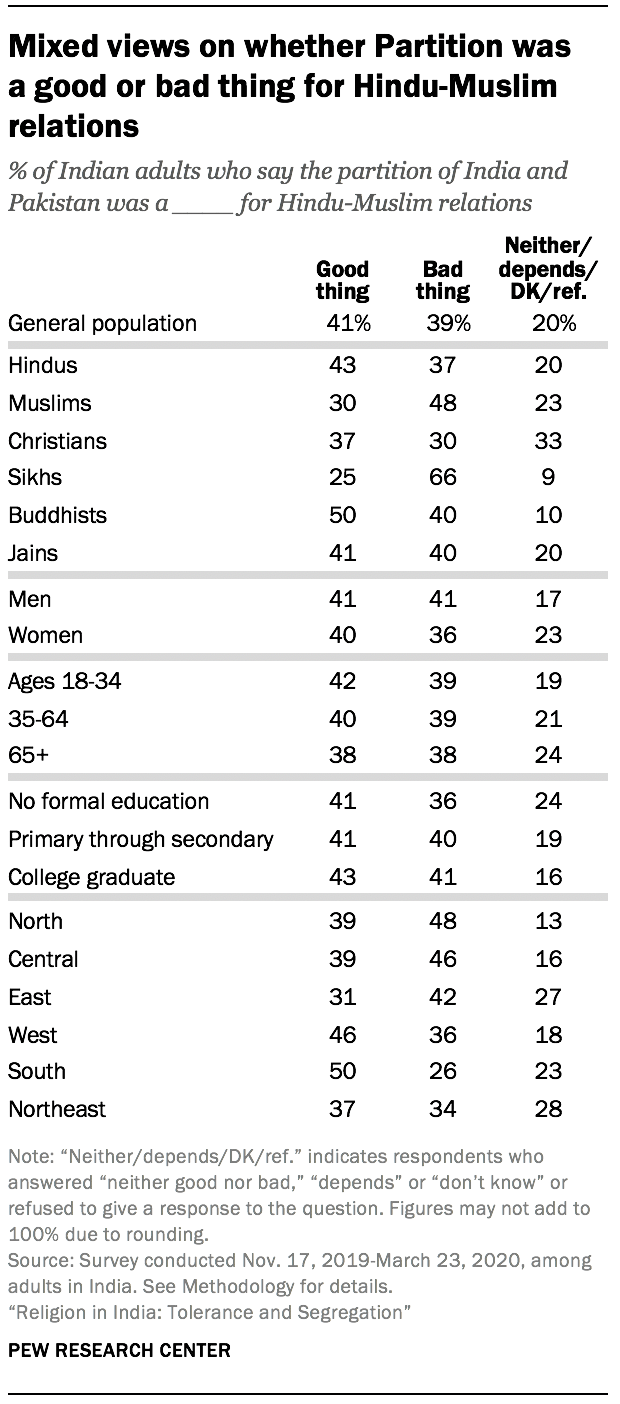
About four-in-ten (41%) say the partition of India and Pakistan was a good thing for Hindu-Muslim relations, while a similar share (39%) say it was a bad thing. The rest of the population (20%) does not provide a clear answer, saying Partition was neither a good thing nor a bad thing, that it depends, or that they don’t know or cannot answer the question. There are no clear patterns by age, gender, education or party preference on opinions on this question.
Among Muslims, the predominant view is that Partition was a bad thing (48%) for Hindu-Muslim relations. Fewer see it as a good thing (30%). Hindus are more likely than Muslims to say Partition was a good thing for Hindu-Muslim relations (43%) and less likely to say it was a bad thing (37%).
Of the country’s six major religious groups, Sikhs have the most negative view of the role Partition played in Hindu-Muslim relations: Nearly two-thirds (66%) say it was a bad thing.
Most Indian Sikhs live in Punjab, along the border with Pakistan. The broader Northern region (especially Punjab) was strongly impacted by the partition of the subcontinent, and Northern Indians as a whole lean toward the position that Partition was a bad thing for Hindu-Muslim relations (48%) rather than a good thing (39%).
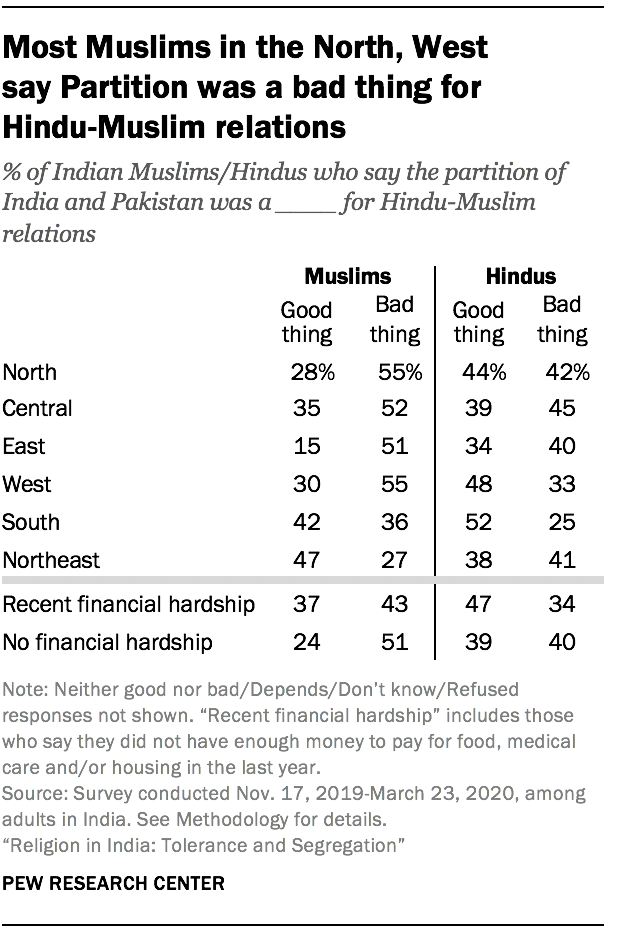
Attitudes toward Partition also vary considerably by region within specific religious groups. Among Muslims in the North and West, most say Partition was a bad thing for Hindu-Muslim relations (55% of Muslims in both regions). In the Eastern and Central parts of the country as well, Muslim public opinion leans toward the view that Partition was a bad thing for communal relations. By contrast, Muslims in the South and Northeast tend to see Partition as good for Hindu-Muslim relations.
Among Hindus, meanwhile, those in the North are closely divided on the issue, with 44% saying Partition was a good thing and 42% saying it was a bad thing. But in the West and South, Hindus tend to see Partition as a good thing for communal relations.
Poorer Hindus – that is, those who say they have been unable to afford basic necessities like food, housing and medical care in the last year – tend to say Partition was a good thing. But opinions are more divided among Hindus who have not recently experienced poverty (39% say it was a good thing, while 40% say it was a bad thing). Muslims who have not experienced recent financial hardship, however, are especially likely to see Partition as a bad thing: Roughly half (51%) say Partition was a bad thing for Hindu-Muslim relations, while only about a quarter (24%) see it as a good thing.
Sign up for our Religion newsletter
Sent weekly on Wednesday
Report Materials
Table of contents, india’s sex ratio at birth begins to normalize, how indians view gender roles in families and society, key facts about the religiously and demographically diverse states of india, religious composition of india, key findings about the religious composition of india, most popular.
About Pew Research Center Pew Research Center is a nonpartisan fact tank that informs the public about the issues, attitudes and trends shaping the world. It conducts public opinion polling, demographic research, media content analysis and other empirical social science research. Pew Research Center does not take policy positions. It is a subsidiary of The Pew Charitable Trusts .
Academia.edu no longer supports Internet Explorer.
To browse Academia.edu and the wider internet faster and more securely, please take a few seconds to upgrade your browser .
Enter the email address you signed up with and we'll email you a reset link.
- We're Hiring!
- Help Center

Politics and Religion in India: An Analysis Introduction

The simple thesis is of this paper is that religion and politics were never purely or completely separated in India, in spite of the contributions of modernity and hence it is necessary to strive hard to separate them as secularism seems to be more viable in a pluralistic context. While working towards this direction, it may also be asked how best positive religious insights can guide political wisdom. To derive at this point, I shall attempt a sketchy and graphic historical development of the process of secularization leading to the formulation of secularism and secular state. While attempting to do so, I shall also highlight the never-ceasing influence of religion on politics and how politicization of religion takes place. To prove the thesis I shall analyze the role of Congress party, emergence of Muslim League and religious interest organizations leading to the formation of BJP. Considerable space shall be devoted for the patterns in which BJP attempts to subscribe to communal politics. Before concluding the analysis the areas and issues that need to be considered and addressed can be underlined. 1 Traditional Society The ideological component in traditional societies was provided almost entirely by religion; secular political ideologies did not exist, and the legitimacy of the ruler was based on religious ideas. The religiopolitical system was an integrated system in which ruler, clergy, religious ideology, religious norms of behaviour, and coercive governmental power were combined in order to maximize the stability of society. 1 It is also often true that "in the intricately woven fabric of traditional systems, the political functions of the clergy were no less important than the religious role of the king." 2 In general, the sway of religion over politics was noteworthy in traditional societies because religion is a mass phenomenon, politics is not; but religion can be used to make politics meaningful. Religious values are also an important influence on political culture, and predispose individuals and societies toward certain patterns of political life. 3 The preponderance of religion over politics in specific in the traditional societies has been challenged in the modern society. Here there is a conscious, but often unsuccessful, attempt to distinguish between religion and the other aspects of life. To understand this phenomenon it shall be appropriate to circumscribe modern period.
Related Papers
Abbad Kamal
Sabah Mofidi
The studies on various societies and the recent changes in some countries show that religion whether as a social structure or an important part of culture, still has some important social functions. This book has followed the use of religion in politics in a society still traditional but with a secular state. It is an attempt to understand why religion is important in politics and politicians still use it. For this purpose, India as a context of the study has been examined. The study tries to find out the reasons for the continuous relevance of religion in the Indian political arena. It clarifies the different aspects of political function of religion in contemporary India and the political groups or leaders who have made an effective use of this function. It also tries to explore the impact of the new situation in post-independence India on the political functions of religion in the country. The book, originally written in 2013 as a PhD thesis, which mentions a possible Abrahamic agreement between Islamic, Jewish and Christian states (p. 62), similar to what was later happened in 2020 under Abraham Accords between USA, Israel and Arab countries. It is available upon request.
International Journal of Contemporary Issues
This article has examined the political function of religion in elections. It has tried to answer the following questions: How has the electoral function of religion been in contemporary India? Which political groups or parties in India have made an effective use of and gained an advantage of the political function of religion in elections? For this purpose, the function of parties and politicians during elections in pre and post-independence India has been regarded. The findings shows that using the religious motions in politics during post independence until the early 21st century has continued and in comparison with pre-independence it has been enhanced, though being a secular state. As India has still a traditional society with variety of religions, using political function of religion has been prevalent.
International Journal of Research in Applied, Natural and Social Sciences
In the modern age without fundamentalism as a middle stage, reaching the level of political religion is not possible even in religious and traditional society. Without making a space or field by fundamentalists and against modernity, the forming of theocratic state and using the political function of religion by religio-political groups is difficult. Maybe the relationship between religious fundamentalism and political religion is so obvious that it triggers questions as; is political religion possible without fundamentalist reaction in this modern era of traditional society? Does every fundamentalist movement lead to theocratic state? How is the relationship between religious fundamentalism and political religion? Or in the other words, what is the requirement or main factor of emergence of political religion? This article tries to answer these questions and clarify the priority of fundamentalism, as a requirement for political religion in modern age. However, it is possible for a traditional society to remain with a secular state. We can relatively witness the separation between religion and state but not separation of religion from politics. So, a traditional society in itself will not suffice in attaining a full-fledged political religion and religious government; and hence the need of fundamentalism becomes the crux of the hour.
Logos i Ethos
Karol Jasiński
Thomas J Altmeppen
SKIREC Publication- UGC Approved Journals
Religion which has always appealed to human nature's unalterable laws and particularly its existential desires and afflictions is no doubt one of the oldest and most deep-rooted institutions on Earth. It is a divine reflection of mankind's craving and effort to interrogate and understand the reasons of creation of the universe, the meaning of life on Earth and the life after death. Religion, as the most outstanding basis of tradition, law and politics at the same time, obviously deserves to be the most vigorous founding body of the society, as well as the individuals' ontological resource of peace and security provided with its heavenly, celestial knowledge references. Hence, having an important influence on forming the individuals' worldview in general and correspondingly their political perception and identities, it is widely taken into consideration as an efficient factor before all else in the processes of academic studies and scientific researches on political issues such as political attitude, voting behaviour and electoral behaviour. Various theories or models have been produced concerning the relationship between religious belief and political behaviour so far. However, among all those others particularly " Sociological Model " and " Psycho-Social Model " (Michigan Model) are much more related to the issue. Thus, the relationship between them was examined in the light of those two models in this article.
Journal of Appl ied Environmental and Biological Sciences
Dr. Husnul Amin
This paper attempts to examine critically the active role of religion in Indian politics in the years 1990-2010. Constitutionally, India is a secular state and does not claim any religion as her official religion. Despite having such a status, her attitude towards religious minorities is indomitable. This anomaly has provided Hindutva to play a key role in her politics. This role of Hindutva became prominent especially in the last two decades. The most significant departure from secularism is observed in the 1990s that set the stage for the rise of the right wing political parties. They have used Hindutva as an instrument of populism in their electoral campaigns. This became evident more and more in the emergence of the BJP as one of the major political parties on Indian political scene. This research attempts to analyze that how the emerging role of religion in the mainstream politics in India threatens the viability of India as a secular state. Besides, this also attempts to analyze how historically this role of religion in Indian politics has implications for minorities especially in the years 1990-2010. Descriptive-analytical method is being used to substantiate the questions.
Acta Ethnographica Hungarica
Gábor Barna
Walisongo: Jurnal Penelitian Sosial Keagamaan
This article discusses the position of religion in politic that has relation to leadership. The main argumentation of this research is religion will constantly become a political power and social movement. In one side the research has different opinion from the integration politic paradigm and secular that proposed by Hasan al-Bannā and 'Alī Abd. al-Rāziq, but in another side, it has reinforced the two paradigms. By using literature study and descriptive method and philosophical historical approach, it indicates Is-lam will constantly exist and has influence in the political process. Although Islam is not depending on politic and on the contrary. Islam and politic are both integrated dimension of life, so both are not able to be separated from social politic dynamics. Artikel ini membahas kedudukan agama dalam politik yang ber-kaitan dengan kepemimpinan. Argumentasi utama penelitian ini adalah bahwa agama tetap akan menjadi kekuatan politik dan gerakan sosial. Di satu sisi penelitian ini berbeda pendapat den-gan paradigma politik integrasi dan sekuler yang dikemukakan oleh Hasan al-Bannā dan 'Alī Abd. al-Rāziq, namun di sisi lain memperkuat kedua paradigma tersebut. Dengan menempuh studi kepustakaan dan menggunakan metode deskriptif serta pendekat-an filosofis dan historis, penelitian ini menunjukkan bahwa Islam akan tetap eksis dan berpengaruh dalam proses politik. Hakikat Islam meskipun tidak bergantung pada politik dan begitu pula
RELATED PAPERS
BMC Research Notes
Mohammad Arabestani
Nafisah Ainun Nisa
László Arató
The Review of Laser Engineering
Sunao Kurimura
Siegfried G. Richter
Nova Tellus
Martha Patricia Irigoyen
Obstetrics & Gynecology
Angelina Gangestad
European Heart Journal
David Prior
Journal Of Pain & Palliative Care Pharmacotherapy
Sandra Waters
Lubna Sheikh
Dwy Puspita Sari
Daniela Rojas
Tadrib: Jurnal Pendidikan Agama Islam
ermis suryana
Studies in History and Philosophy of Science Part B: Studies in History and Philosophy of Modern Physics
Jaume Navarro
Ricardo Triska
Eric Podico
Dr. Aradhana Sen
Materials Science and Engineering: A
Toshihiko Shimamoto
Journal of Intelligent Information Systems
Elena Carasec
Journal of Horticultural Research
Yusuf Çelik
Fatima z Bouchikhi
Complex & Intelligent Systems
Mehdi Amiri
Proceedings of the first international joint conference on Autonomous agents and multiagent systems part 1 - AAMAS '02
Charles Adams
Zenodo (CERN European Organization for Nuclear Research)
Josephine Akoloh-Isaac
Journal of Hazardous Materials
Nishad Fathima
See More Documents Like This
- We're Hiring!
- Help Center
- Find new research papers in:
- Health Sciences
- Earth Sciences
- Cognitive Science
- Mathematics
- Computer Science
- Academia ©2024

IMAGES
VIDEO
COMMENTS
The India’s partition of 1947 was arguably the backdrop to formation of political groups and institutions that emerged on religious divide. Thought to be the solution towards political differences between the Hindus and the Muslim, the 1947 partition itself was the course of major political pressures in India (Moore 371).
The intertwining of religion and politics in India is deeply rooted in its historical context. The nation’s partition in 1947, based on religious lines, set the stage for religion to become a central player in political discourse. The political ideologies that emerged, such as secularism and communalism, were deeply influenced by religious ...
The mobilization of religion for political purposes has a long and troubled history in the Indian subcontinent, from the consolidation of electoral blocs to inter-community violence. Its deployment to define and circumscribe legal citizenship is relatively new in India, though arguably not in the subcontinent, the very object of whose ...
The Pew Research Center’s largest study of India explores the intersection of religion and identity politics. Bounded on the north by the Himalayas, east by the Ganges River and Bay of Bengal, west by the otherworldly salt marshes known as the Rann of Kutch, and south by the spice-scented Cardamom Hills, India’s 1.4 billion citizens revere deities as diverse as their nation’s topography ...
In the case of India, the commingling of religion and politics is hardly novel. This mixing first began with state patronage of the Brahminical Vedic tradition in which state backing of religion ensured that clerical leaders would, in turn, protect the state. 6 In India’s earliest state formations, the rajas (kings) wielded political power but were reliant on the legitimation of brahmins ...
The vast majority of Indians say they are very free today to practice their religion (91%), and all of India’s major religious groups share this sentiment: Roughly nine-in-ten Buddhists (93%), Hindus (91%), Muslims (89%) and Christians (89%) say they are very free to practice their religion, as do 85% of Jains and 82% of Sikhs.
As India celebrates 75 years of independence, fresh questions are being raised about who is an Indian. This essay introduces a special section of Studies in Indian Politics which puts forward answers to this question considering recent tectonic changes in India’s political climate and party system. We outline how religion is being ...
This research attempts to analyze that how the emerging role of religion in the mainstream politics in India threatens the viability of India as a secular state. Besides, this also attempts to analyze how historically this role of religion in Indian politics has implications for minorities especially in the years 1990-2010.
'Political science can and should study the impact of religion on politics. This important book clearly articulates, and brilliantly demonstrates, how and why in India, high religious practice, more than caste, civil society, or parties, is the most significant variable associated with Indian citizens’ positive sense of political representation.'
This book has followed the use of religion in politics in a society still traditional but with a secular state. It is an attempt to understand why religion is important in politics and politicians still use it. For this purpose, India as a context of the study has been examined. The study tries to find out the reasons for the continuous ...